traction control AUDI RS7 SPORTBACK 2015 Owners Manual
[x] Cancel search | Manufacturer: AUDI, Model Year: 2015, Model line: RS7 SPORTBACK, Model: AUDI RS7 SPORTBACK 2015Pages: 302, PDF Size: 74.76 MB
Page 189 of 302
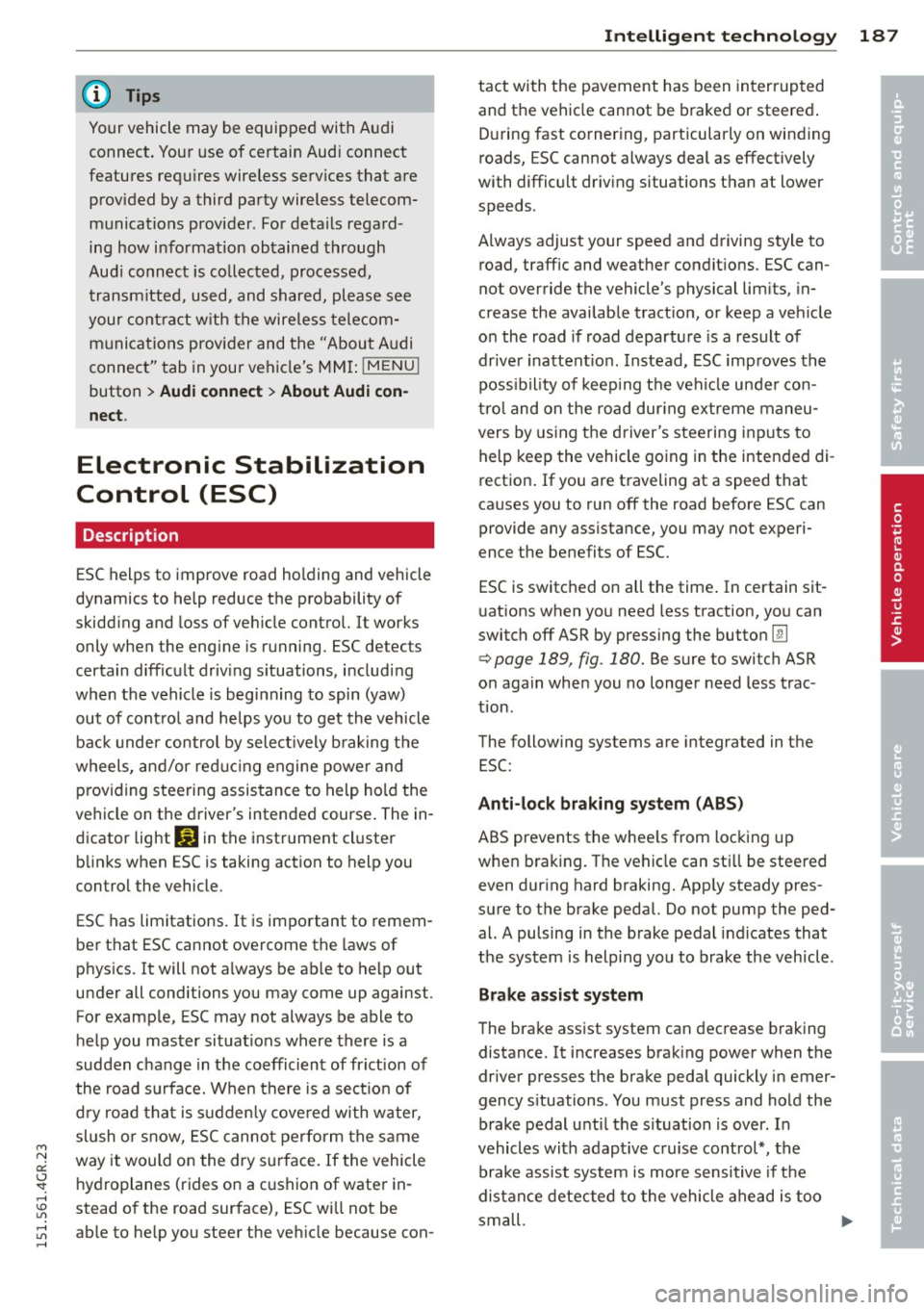
M N
0:: <.J 'SI: ,...., \!) ..,.,
,...., ..,., ,....,
@ Tips
Your vehicle may be equipped with Audi
connect. Your use of certain Aud i connect
features req uires wireless serv ices that are
provided by a third party wireless telecom
municat ions provider. For details regard
ing how information obtained through
Aud i connect is collected, processed,
transmitted, used, and shared, please see
your contra ct w ith the wire less telecom
municat ions provider and the "About A udi
connect" tab in your vehicle's MMI:
!MENU !
button > Audi connect > About Audi con·
nect .
Electronic Stabilization
Control (ESC)
Description
ESC helps to improve road holding and vehicle
dynamics to help reduce the probability of
skidd ing and loss of veh icle control. It works
only when the eng ine is running. ESC detects
certain difficult driv ing s ituations, including
when the vehicle is beginning to spin (yaw)
out of cont ro l and helps you to get the vehicle
back under control by select ively brak ing the
wheels, and/or red ucing engine powe r and
p roviding steering assistance to help hold the
ve hicle on the driver's intended course . The in
dicator light
m in the instrument cluster
blinks when ESC is taking action to help you
control the vehicle.
ESC has limitations.
It is important to remem
ber that ESC cannot overcome the laws of
phys ics. It will not a lways be able to help out
under all conditions you may come up against.
For example, ESC may not always be able to
h elp you master situat ions where there is a
sudden change in the coefficient of fr iction of
the road surface. When there is a sect io n of
d ry road that is s udden ly cove red with water,
slush o r snow, ESC canno t perform the same
way it would on the dry su rface.
If the vehicle
hydroplanes (rides on a c ush ion of wate r in
stead of the road surface), ESC wi ll not be
ab le to he lp you steer the veh icle because con-
Int ellig ent technolog y 187
tact with the pavement has been interrupted
and the vehicle cannot be braked or steered .
D uring fast corner ing, particular ly on wind ing
roads, ESC cannot always deal as effectively
with difficult dr iv ing s ituations than at lower
speeds.
A lways adjust your speed and driving style to
road, traffic and weather condit ions. ESC can
not override the vehicle's physical lim its, in
crease the availab le tract ion, or keep a veh icle
o n the road if road departu re is a result of
drive r inattent io n. Instead, ESC imp roves the
poss ibility of keep ing the vehicle unde r con
trol and on the road dur ing extreme maneu
vers by using the driver's steering inp uts to
help keep the vehicle going in the intended di
rection . If you are traveling at a speed that
causes you to run off the road before ESC can
provide any assistance, you may not experi
ence the benefits of ESC.
ESC is switc hed on all the time . In certain sit
uat ions when you need less traction, yo u can
switch off ASR by pressing the button
[&I
c::> page 189, fig. 180. Be sure to switch ASR
o n again when you no longer need less t rac
t ion.
The following systems are integrated in the
ESC:
Anti-lock bra king sy stem (ABS )
ABS prevents the whee ls from locking up
whe n brak ing. The vehicle can sti ll be stee red
even dur ing hard braking. App ly steady pres
s u re to the brake pedal. Do not pump the ped
al. A pulsing in the brake pedal indicates that
the system is helping you to brake the vehicle.
Brake as sist sy stem
The brake assist system can decrease braking
distance. It increases brak ing power when the
driver presses the brake peda l quickly in emer
gency s ituations. You must press and hold the
brake pedal until the situation is over. In
vehicles with adapt ive c ruise control*, the
brake assist system is more sensitive if the
distance detected to the vehicle ahead is too
small.
•
•
Page 192 of 302
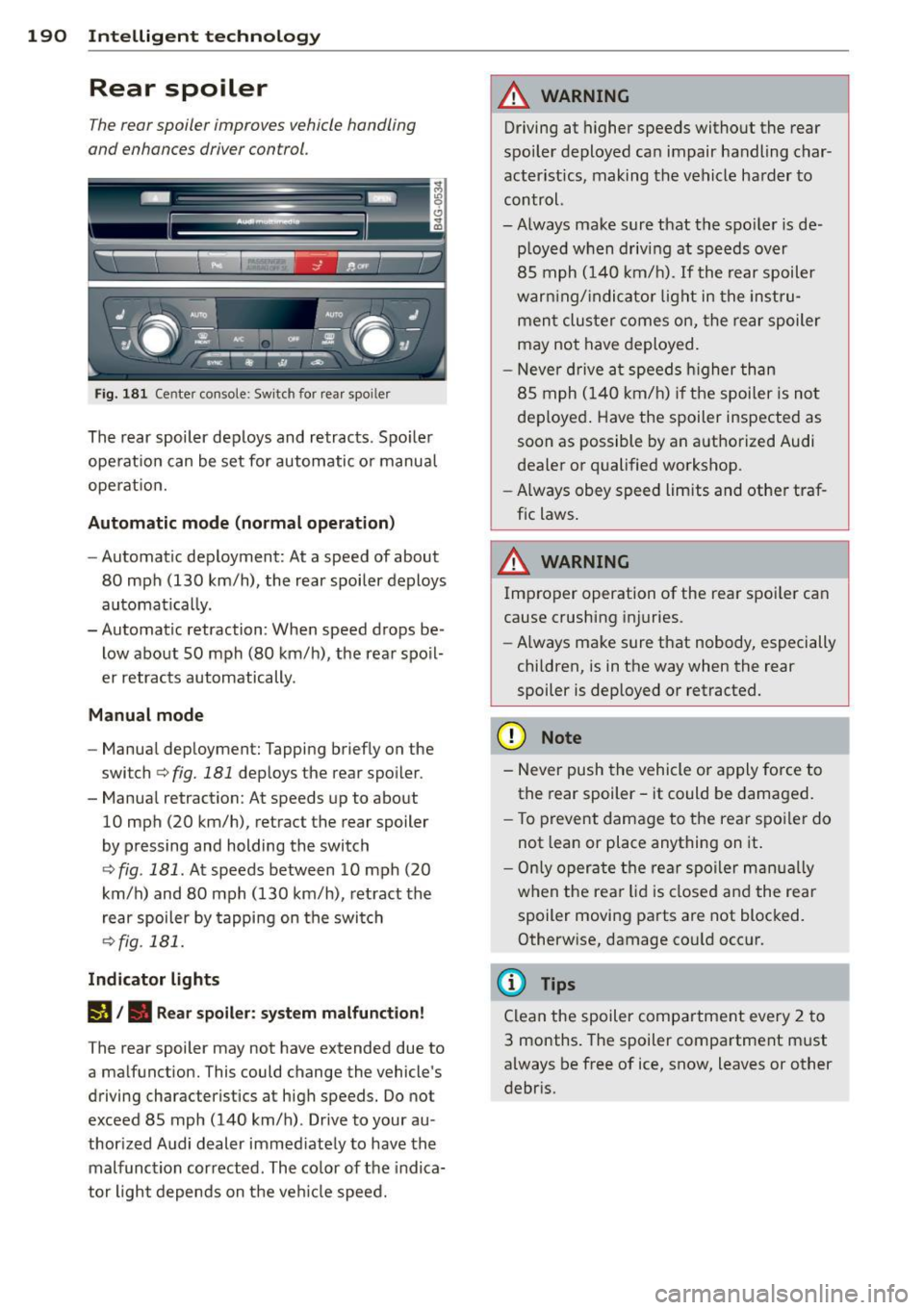
190 Intelligent technology
Rear spoiler
The rear spoiler improves vehicle handling
and enhances driver control.
Fig. 181 Center console: Switch for rear spo iler
The rear spoiler deploys and retracts. Spoiler
operation can be set for automatic or manual
operat ion.
Automatic mode (normal operation)
-Automatic deployment: At a speed of about
80 mph (130 km/h), the rear spoiler deploys
automatically.
- Automatic retraction: When speed drops be
low about SO mph (80 km/h), the rear spoil
er retracts automatically.
Manual mode
- Manual deployment: Tapping briefly on the
switch
c:> fig. 181 deploys the rear spoiler .
- Manual retraction: At speeds up to about
10 mph (20 km/h), retract the rear spoiler
by pressing and holding the switch
c:> fig. 181 . At speeds between 10 mph (20
km/h) and 80 mph (130 km/h), retract the
rear spoiler by tapping on the switch
<=?fig. 181.
Indicator lights
I)/. Rear spoiler: system malfunction!
The rear spoiler may not have extended due to
a malfunction. This could change the vehicle's
driving characteristics at high speeds. Do not
exceed 85 mph (140 km/h). Drive to your au
thorized Audi dealer immed iately to have the
malfunction corrected . The co lor of the indica
tor light depends on the veh icle speed.
A WARNING
-Driving at higher speeds without the rear
spoiler deployed can impair handling char
acteristics, making the vehicle harder to
control.
-Always make sure that the spo iler is de
p loyed when driving at speeds over
85 mph (140 km/h) . If the rear spoiler
warn ing/ indicator light in the instru
ment cluster comes on, the rear spoiler
may not have deployed.
- Never drive at speeds higher than
85 mph (140 km/h) if the spoiler is not
deployed. Have the spoiler inspected as
soon as possible by an authorized Audi
dealer or qualified workshop.
- Always obey speed limits and other traf
fic laws.
A WARNING
Improper operation of the rear spoi ler can
cause crushing injuries.
- Always make sure that nobody, especially
children, is in the way when the rear
spoiler is deployed or retracted.
(D Note
- Never push the vehicle or apply force to
the rear spoiler -it could be damaged.
- To prevent damage to the rear spo iler do
not lean or place anything on it.
- Only operate the rear spoiler manually
when the rear lid is closed and the rear
spoiler moving parts are not blocked. Otherwise, damage cou ld occur.
(D Tips
Clean the spoiler compartment every 2 to
3 months. The spoiler compartment must
always be free of ice, snow, leaves or other
debris.
Page 195 of 302
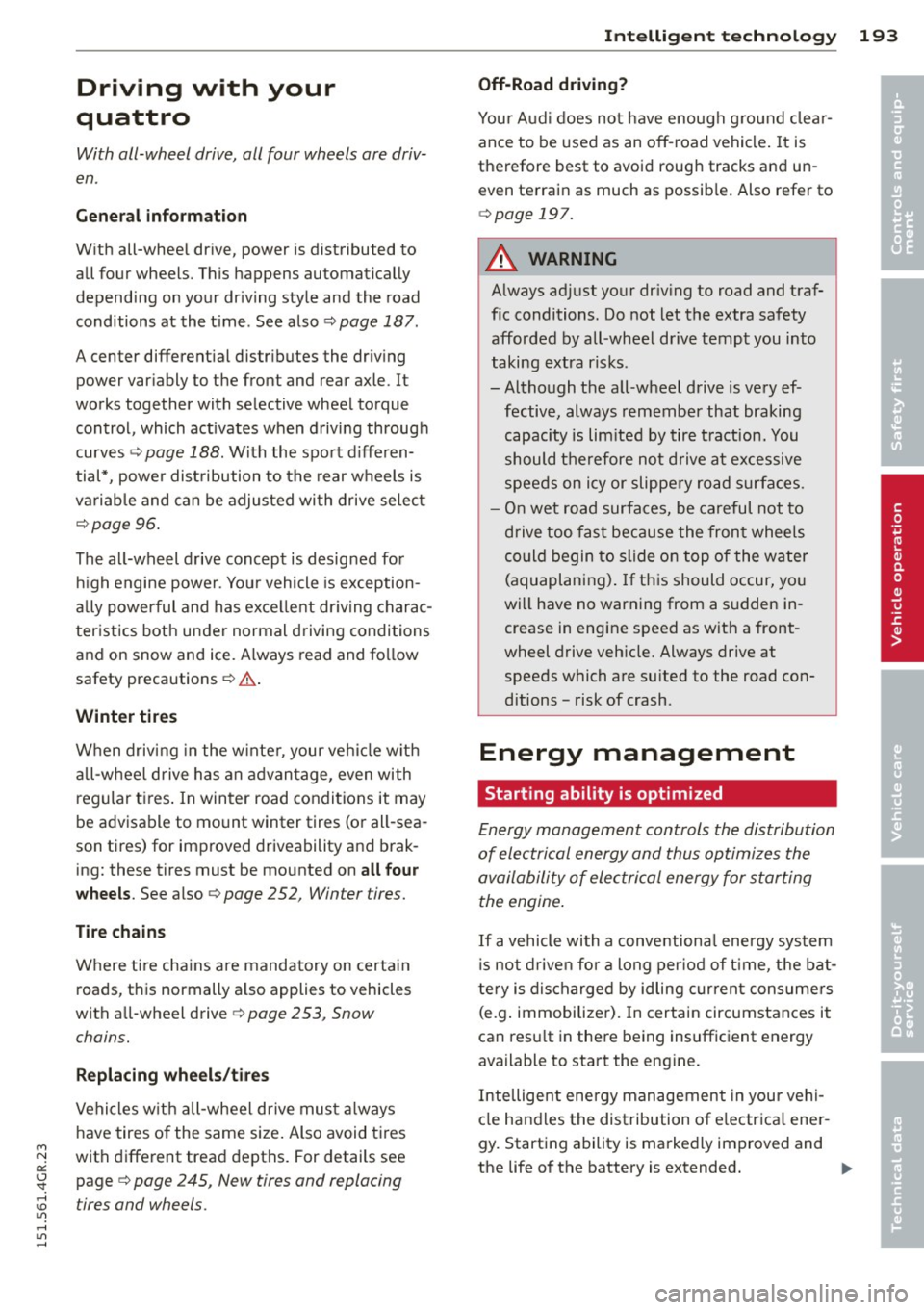
M N
0:: <.J 'SI:
Driving with your
quattro
With all-wheel drive, all four wheels are driv
en .
General information
With all-wheel drive, power is distributed to
all four wheels . This happens automatically
depending on your driving style and the road
conditions at the time . See also ¢
page 187.
A center differential distributes the driving
power variably to the front and rear axle. It
works together with selective wheel torque
control, which activates when driving through
curves ¢
page 188 . With the sport d ifferen
tial*, power distribution to the rear wheels is
va riable and can be adjusted with drive select
¢page 96.
The all-wheel drive concept is designed for
hi gh engine power. Your vehicle is exception
ally powerful and has exce llent dr iving charac
teristics both under normal driving conditions
and on snow and
ice. Always read and follow
safety precautions ¢.& .
Winter tires
When driving in the w inter , your ve hicle with
all-wheel drive has an advantage, even with
regular tires. In winter road conditions it may
be advisable to mount winter tires (or all-sea
son t ires) for improved driveability and brak
ing: these tires must be mounted on
all four
wheels. See also ¢ page 252, Winter tires.
Tire chains
Where tire chains are mandatory on certain
roads, this normally a lso applies to vehicles
with a ll-wheel drive¢
page 253, Snow
chains.
Replacing wheels/tires
Vehicles w ith all-wheel drive must always
have tires of the same size. Also avoid tires
with different tread depths. For details see
page ¢
page 245, New tires and replacing
~ tires and wheels . 1.1'1 ,...., 1.1'1 ,....,
Intelligent technology 193
Off•Road driving?
Your Audi does not have enough g round clear
ance to be used as an off-road vehicle.
It is
therefore best to avoid rough tracks and un
even terrain as much as possible. Also refer to
¢page 197.
A WARNING
Always adjust your dr iv ing to road and traf
fic conditions. Do not let the extra safety
afforded by all-wheel drive tempt you into
taking extra risks.
- Although the all-wheel drive is very ef fective, always remember that braking
capacity is lim ited by tire traction. You
should therefore not drive at excessive
speeds on icy or slippery road surfaces.
- On wet road surfaces, be careful not to
drive too fast because the front wheels
could begin to slide on top of the water
(aquaplaning) . If this should occur, you
will have no warning from a sudden in
crease in engine speed as with a front
wheel drive veh icle. Always drive at
speeds which are su ited to the road con
ditions - risk of crash.
Energy management
Starting ability is optimized
Energy management controls the distribution
of electrical energy and thus optimizes the
availability of electrical energy for starting
the engine .
If a vehicle with a conventiona l energy system
is not driven for a long period of tim e, the bat
tery is discharged by idling current consumers
(e.g . immobilizer). In certain circumstances it
can resu lt in there being insufficient energy
available to start the eng ine.
Intelligent energy management in your vehi
cle handles the distribution of e lectrica l ene r
gy. Starting ability is markedly improved and
the life of the battery is extended .
ll>
•
•
Page 251 of 302
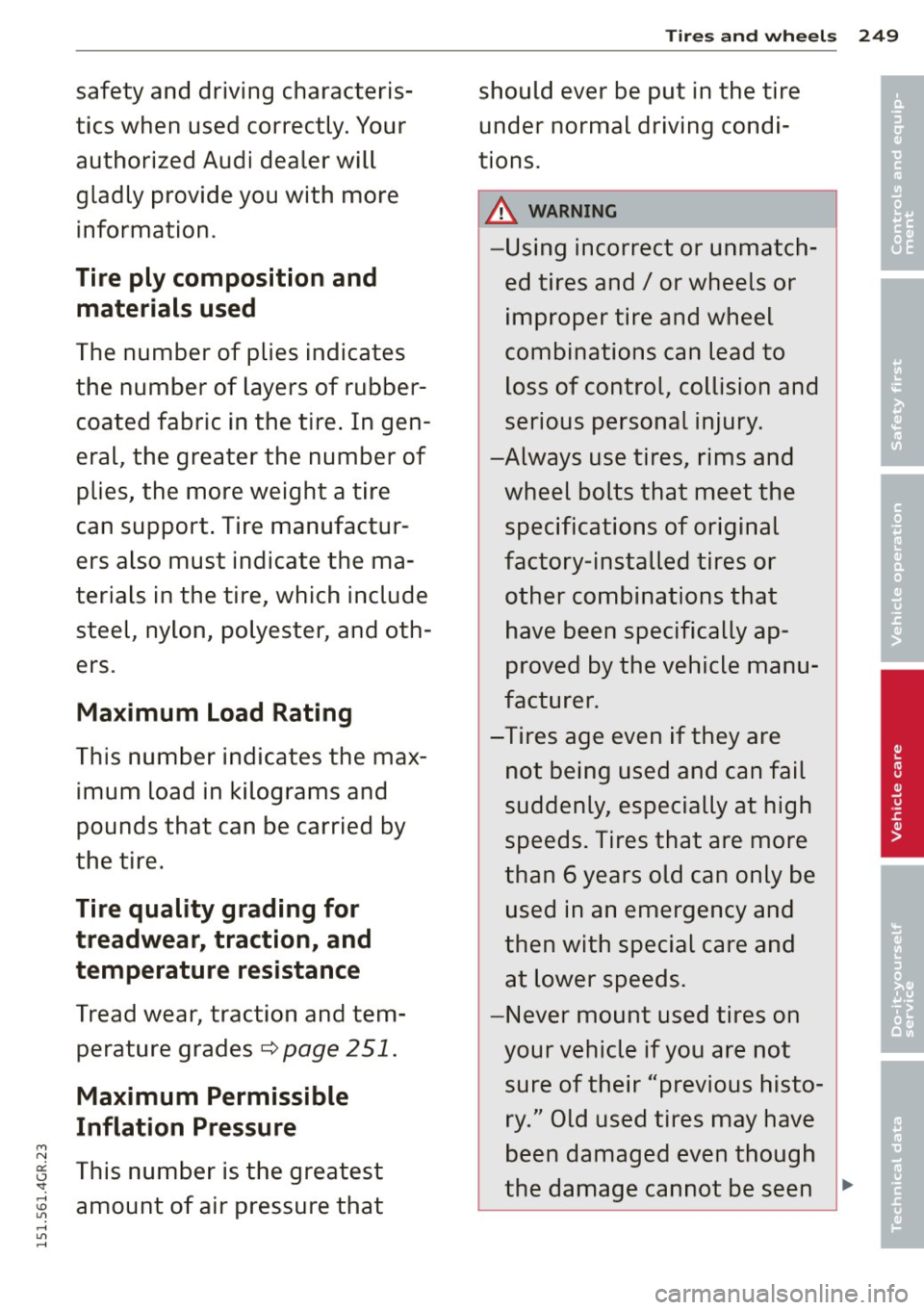
Tires and wheels 249
safety and driving characteris- should ever be put in the tire •
tics when used correctly. Your under normal driving condi-• '
authorized Audi dealer will tions.
gladly provide you with more
A WARNING
information.
-Using incorrect or unmatch-
Tire ply composition and ed tires and / or wheels or
materials used improper tire and wheel
The number of plies indicates combinations can lead to
the number of layers of rubber- loss of control, collision and coated fabric in the tire. In gen- serious personal injury.
eral, the greater the number of -Always use tires, rims and
plies, the more weight a tire wheel bolts that meet the
can support. Tire manufactur- specifications of original
ers also must indicate the ma-
factory-installed tires or
terials in the tire, which include other combinations that
steel, nylon, polyester, and oth- have been specifically ap-
ers. proved by the vehicle manu-
Maximum Load Rating
facturer.
-Tires age even if they are
This number indicates the max- not being used and can fail
imum load in kilograms and suddenly, especially at high
pounds that can be carried by speeds. Tires that are more
the tire. than 6 years old can only be
Tire quality grading for used in an emergency and
treadwear, traction, and then with special care and
temperature resistance at lower speeds.
Tread wear, traction and tern- -Never mount used tires on
perature grades¢
page 251. your vehicle if you are not
Maximum Permissible
sure of their "previous histo-
Inflation Pressure ry." Old used tires may have
M been damaged even though N
0:: This number is the greatest <.J
the damage cannot be seen .... 'SI: ,....,
amount of air pressure that \!) 1.1'1 ,...., 1.1'1 ,....,
Page 253 of 302
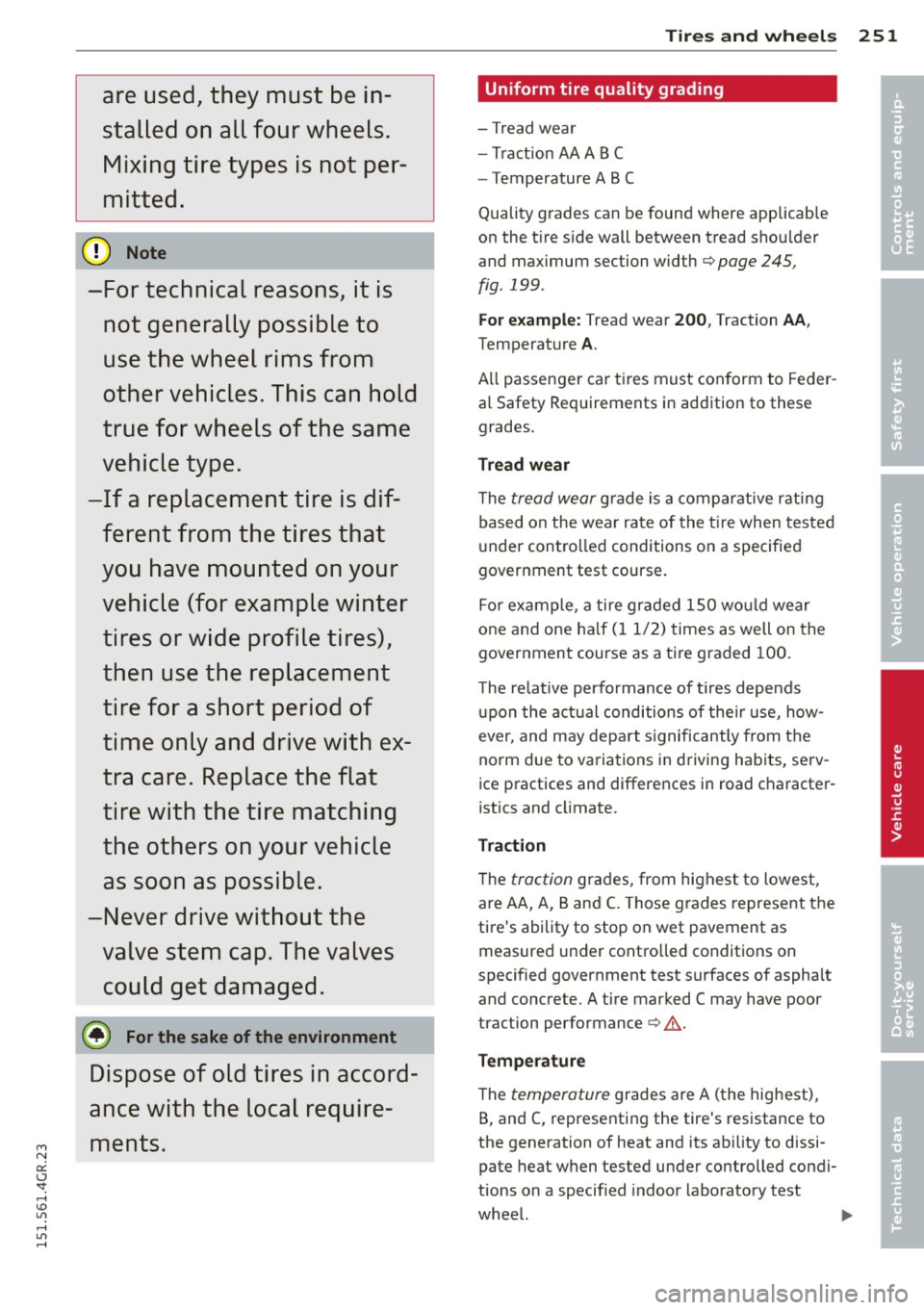
M N
0:: <.J 'SI: ,...., \!) 1.1'1 ,...., 1.1'1 ,....,
are used , they must be in
stalled on all four wheels. Mixing tire types is not per
mitted.
(D Note
-For technical reasons, it is not generally possible to
use the wheel rims from
other vehicles. This can hold
true for wheels of the same
vehicle type.
- If a replacement tire is dif
ferent from the tires that
you have mounted on your
vehicle (for example winter
tires or wide profile tires),
then use the replacement
tire for a short period of
time only and drive with ex
tra care. Replace the flat
tire with the tire matching
the others on your vehicle
as soon as possible.
- Never drive without the
valve stem cap. The valves
could get damaged .
@) For the sake of the environment
Dispose of old tires in accord
ance with the local require ments.
Tires and wheels 251
Uniform tire quality grading
- Tread wea r
- Traction AA A B C
- Temperature AB C
Quality g rades ca n be foun d where applicab le
on the t ire s ide wall between t read sho ulder
and maximum section width
c> page 245,
fig. 199 .
For example : Tread wear 200, Traction AA,
Temperat ure A.
All passenge r ca r tir es must con form to Feder
a l Safety Requ irements in add ition to these
grades.
Tread wear
T he tread we ar g rade is a c omp arati ve r ati ng
based on the wea r rat e of the tire when tes te d
u nder con tro lled conditions o n a specifie d
government test course .
F o r ex ample, a tire gr aded 1S 0 wo uld wear
one a nd one h alf ( 11 /2 ) times as well on the
governmen t course as a ti re g raded 100 .
T he re la tive perfo rman ce of tires depe nds
up on the actu al c ondition s of the ir u se, how
ever, and m ay dep art s ignificantly from t he
no rm due to va ria tions i n driving ha bits, se rv
ice p ractices and differences in road c haracter
istics and cl imate.
Traction
T he trac tio n gr ad es, from hig hest to lowes t,
a re AA, A, Ban d
C. Those g rades represe nt the
ti re 's ability to stop on wet pavement as
measured u nder cont rolled conditions on
specified government test surfaces of aspha lt
and concrete. A t ire mar ked C may have poor
traction performance
c> ,&. .
Temperature
The temperature gr ades are A (the highest),
B, and C, represent in g the tire's resistance to
the generation of heat and its ab ility to d issi
pate heat when tested un der controlled condi
tions on a specif ied indoo r labo rato ry test
whee l.
•
•